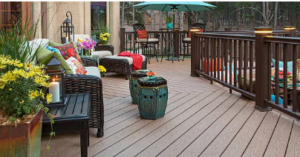Composite decks require minimal upkeep, and they don’t need re-staining like traditional wood. These composite decking Adelaide also come in a wide variety of colours, making it easy to find a tone/shade that suits your aesthetic style.
 But there are a few things to consider before you choose composite.
But there are a few things to consider before you choose composite.
Cost
One drawback of composite is that it tends to have higher upfront costs than other materials. However, the extra cost is offset by the fact that it will save you money in the long run due to its minimal maintenance requirements.
Another advantage of composite decks is that they are resistant to rot, unlike natural wood. It helps prevent costly repairs in the future. They also don’t require the same level of upkeep as traditional wood, which requires staining and sealing on a regular basis.
Most composite decking is made from a mixture of wood and plastic. Some manufacturers also use recycled materials in their composite products. It gives them an environmentally friendly label and makes them a good choice for anyone looking to improve their home with a low-maintenance deck.
Composite decking is also less susceptible to mould and algae than natural wood. If these problems do develop, however, they can be easily removed with a commercial cleaner or warm, soapy water. In addition, composite decking is not prone to splinters and is safer for people to walk on than wooden decks.
Durability
Composite decks are less susceptible to damage from fungus, termites and mould. Additionally, composite decking Adelaide won’t rot or warp and can withstand heavy foot traffic without showing signs of wear and tear. It makes them a smart investment that will last longer than a wood deck.
While a composite deck may be more expensive upfront than a traditional wooden one, it saves homeowners money in the long run by reducing maintenance costs. Composites also don’t need to be stained or sealed regularly, and they are more durable than wood, which requires re-staining every few years.
Another advantage of composites is that they are slip-resistant and won’t splinter like wood. It helps protect children and pets from injury and reduces the risk of tripping or falling on sharp objects.
Maintenance
Composite decks require a minimal amount of maintenance compared to traditional wood decks. They do not need staining or re-sealing, which saves homeowners time and money on upkeep. They are also resistant to rotting, warping, and insect damage.
Composite boards are also splinter-resistant, which is important for families with children or pets who frequently walk barefoot. Wooden boards can often develop splinters after prolonged exposure to weather changes, which can be uncomfortable and even dangerous for kids and pets.
Most composite decks are made with recycled materials, which is a good thing for the environment. They can help avoid the need to cut down trees for timber, which can lead to deforestation.
Aesthetics
When composites first came on the market, homeowners welcomed them as less demanding alternatives to wood decks. With their durability, low-maintenance appearance and safety (no splinters), they were an attractive choice. But composites aren’t without their drawbacks.
Like traditional wood, composite decking Adelaide can be scuffed by furniture, energetic dogs and gritty shoes. They also tend to stain, though dark composites typically lose their stains over time. They can get hot underfoot, too—although that is less of a problem with lighter-coloured boards.
Many manufacturers have redesigned their products to look more like real wood, and the appearance of capped polymer decking has come a long way in recent years. Even so, some people still prefer the look of natural wood. And, while a homegrown cedar or redwood deck is more expensive than a composite one, those woods offer superior durability and beauty. The natural oils in them resist rot and mould, and they are more resistant to insect damage than pressure-treated pine. Other species, such as ipe (pronounced ee-PAY), mahogany and cumaru (CUH-roo-uh), are even more durable, but they may cost significantly more.